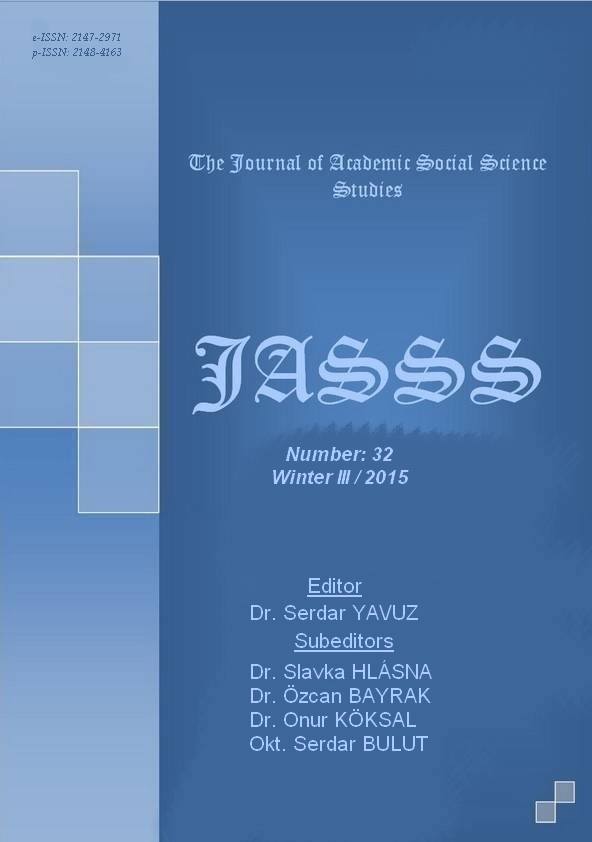Author :
Abstract
Bu çalışma ergenlerin utangaçlık düzeylerinin anne-baba tutumları ve bazı değişkenlerle olan ilişkisini incelemek amacıyla yapılmıştır. Yöntem: Araştırma Çorum ili Sungurlu ilçesinde Milli Eğitim bünyesinde yer alan dört farklı resmi liseden gönüllülük esasına dayalı kalarak, tesadüfi örnekleme yöntemi kullanılarak 121 öğrencinin katılımı ile gerçekleşmiştir. Veri toplamak için Kuzgun ve Eldeleklioğlu (2005) tarafından geliştirilen Ana Baba Tutumları Ölçeği, Güngör (2001) tarafından Türkçe’ye uyarlanan Utangaçlık Ölçeği ve araştırmacılar tarafından geliştirilen kişisel bilgi formu kullanılarak utangaçlığa neden olabilecek farklı değişkenlerin de ilişki düzeyi incelenmiştir. Bulgular: Okul türü, öğrencilerin yaşı, anne-baba öğrenim düzeyi, kardeş sayısı, doğum sırası, yerleşim yeri ve öğrencilerin kaldıkları yer ile utangaçlık arasında anlamlı bir fark bulunamamıştır. Ailenin gelir düzeyinin utangaçlıkla ilişkili olduğu görülmektedir. Yine anne-baba tutumları ile utangaçlık arasında anlamlı bir ilişki bulunamamıştır. Demokratik tutuma sahip ailelerin çocuklarının utangaçlık düzeylerinde düşüş olduğu gözlenirken, koruyucu ailelerin çocuklarının utangaçlık düzeyi puanlarının diğerlerine göre en yüksek olduğu gözlenmiştir. Sonuç: Anne-baba tutumlarının ergenlerin utangaçlık düzeyi ile ilişkisi olmadığı sonucuna varılmıştır. Okul türünün utangaçlığa etkisi incelendiğinde aralarında anlamlı bir fark bulunamamasına karşın Anadolu Öğretmen Lisesi öğrencilerinin utangaçlık puan düzeyi düşük çıkmıştır. Yaşanılan yer ile utangaçlık arasında anlamlı bir farklılık bulunmamıştır. Ergenlerin Anne Baba Tutumları ve Utangaçlık ölçeklerinden aldıkları puanlar incelendiğinde ailenin gelir düzeyinin utangaçlıkla ilişkili olduğu görülmektedir. Ailenin artan gelir düzeyi ile ergenin utangaçlık düzeyine ilişkin aldığı puanlarda düşüş gözlenmektedir.
Keywords
Abstract
This study is conducted to investigate the relation between the shyness levels of adolescents and parents' attitude and some other relevant variables. Method: The study was conducted by means of random sampling method with the participation of 121 students from four different high schools in Sungurlu District of Çorum Province affiliated with the Ministry of National Education based on voluntariness principle. The levels of relations of different variables that might cause shyness were investigated by using Parents’ Attitudes Scale developed by Kuzgun and Eldeleklioğlu (2005), Shyness Scale adapted to Turkish by Güngör (2001) and the personal information form developed by the researchers to collect data. Findings: No significant difference could be determined between shyness and the type of school, students' ages, parents' educational level, the number of siblings, birth order, residence and the type of accommodation. It is seen that the income level of the family is related to shyness. Also, no significant relationships could be determined between shyness and parents' attitudes. While it was observed that the shyness levels of the children from families with democratic attitudes were low, the shyness level scores of the children from protective families is the highest of all. Conclusion: It was concluded that there was no relation between the attitudes of parents and the shyness levels of adolescents. When the effect of the type of school on shyness was investigated, it was determined that the shyness level scores of Anatolian Teacher High School were low although no significant difference could be found between students. No significant difference could be determined between the places students lived and shyness. When the scores adolescents got from Parents' Attitudes and Shyness scales are investigated, it is seen that the income level of a family is related to the shyness. Shyness level scores of adolescents decrease as the income level of the family increases.





